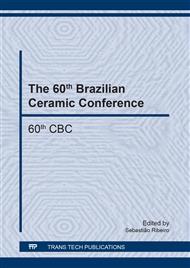p.55
p.60
p.65
p.71
p.77
p.82
p.87
p.93
p.97
Sol-Gel Synthesis of Amorphous Silica Nanoparticles: Study of the Process Parameters Influence on Structure and Particle Size Distribution
Abstract:
The synthesis of silica particles at the nanoscale through the sol-gel method is of great interest due to their potential use in industrial applications. The Stöber method is the most used method for the silica nanoparticles production using ammonia as a catalyst. This work studied the sol-gel synthesis of amorphous silica nanoparticles described by Stöber, in order to evaluate the influence of the variation of the process parameters (molar ratio water/TEOS = 25 and 55, reagent feed rate = 0.6 mL/min and 18 mL/min, pH = 12 and 9 and reaction time of 0, 5, 30, 60 and 120 minutes) on the particle size distribution and structural functional groups. The particle size distribution was analyzed by dynamic light scattering (DLS) and the structural functional groups was analyzed by infrared spectroscopy through Fourier transform (FTIR). The molar ratio water/TEOS influenced the functional groups presents and the time influenced the particle diameter distribution. It was not possible to identify the influence of the feed rate and pH in the results. The particle diameters found were between 200-500nm. This result may be occurred due to mass diffusion and/or nanoparticles aggregation.
Info:
Periodical:
Pages:
77-81
Citation:
Online since:
January 2018
Keywords:
Price:
Сopyright:
© 2018 Trans Tech Publications Ltd. All Rights Reserved
Share:
Citation:


